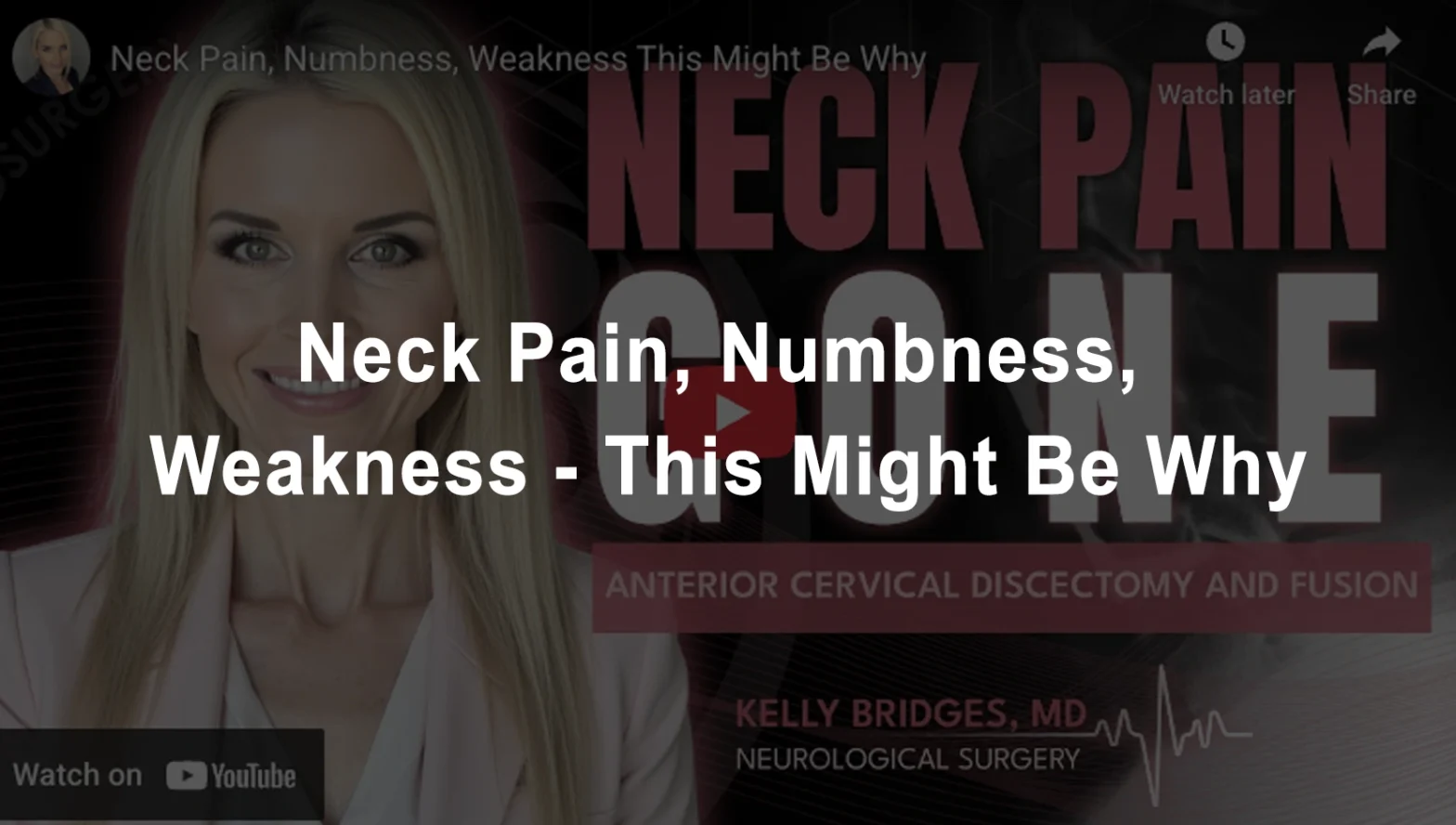Neck Pain, Numbness, Weakness This Might Be Why

Understanding ACDF Surgery: What It Is and Why It’s Done
Today I want to share some insights into one of my favorite procedures. This is called an anterior cervical discectomy and fusion, or ACDF for short.
If you’ve been living with neck pain, arm pain or weakness, numbness, and tingling, you might benefit from an ACDF. As a board-certified neurosurgeon, I’m going to review why the surgery is performed, what it involves, the risks, the benefits, and what to expect during recovery.
What Is an ACDF?
An anterior cervical discectomy and fusion is a common spine surgery. This is a fancy way of saying that we enter through the front of your neck and remove a damaged or herniated disc from between your vertebrae. Then we fuse the bones together to stabilize your spine.
This procedure is commonly done for conditions like herniated discs, degenerative disc disease, spinal stenosis, or bone spurs that compress the spinal cord or nerves causing pain, numbness, or weakness.
When Symptoms Indicate It’s Time for Surgery
Radiculopathy is when a nerve root exiting the spine is compressed, causing pain, numbness, tingling, or weakness that often travels down the arm.
Myelopathy is a more serious condition caused by spinal cord compression, often due to a bulging disc or bone spurs. This can lead to problems such as weakness, incoordination of the arms and legs, and even bowel and bladder dysfunction.
Chronic neck pain involves persistent pain that doesn’t respond to other treatments and is linked to a structural problem in the cervical spine.
The Goal and Benefits of ACDF Surgery
The main goal of an ACDF procedure is to relieve pressure on the spinal cord and nerves while stabilizing the neck. The benefits can be life-changing.
This surgery can significantly reduce or eliminate neck and arm pain, restore strength and coordination, relieve numbness and tingling, and prevent further damage to the spinal cord or nerves. For many patients, ACDF surgery allows them to experience a fast recovery with improved quality of life and minimal disruption of daily activities.
Step-by-Step: What Happens During ACDF Surgery
You’ll be completely asleep under general anesthesia. The surgery begins with an incision made on the front of your neck. This approach avoids cutting through the muscles in the back of the neck and allows direct access to the disc.
Once the incision is made, important structures like the trachea, esophagus, and blood vessels are gently moved aside. Using specialized tools, the surgeon removes the problem disc and bone spurs, creating space and taking pressure off the spinal cord and nerves.
A small device called a cage—made of or filled with bone material—is then placed into the empty disc space to help the vertebrae fuse together over time. Often a small plate and screws are secured to the front of the spine to hold everything in place while the fusion occurs. The incision is then closed and the surgery is complete.
Understanding the Risks
Like any surgery, ACDF has some risks, though they are relatively rare when performed by an experienced surgeon. These include anesthesia-related complications, blood clots, infection, or poor wound healing.
Temporary voice hoarseness or difficulty swallowing can occur. There’s also a small risk of injury to surrounding structures in the neck, failure of the vertebrae to fuse, or future wear and tear on nearby spinal levels.
The good news is that ACDF is a well-established and safe procedure with a very high success rate when performed carefully.
What to Expect After Surgery
Many patients notice immediate relief from arm pain and tingling. Recovery from numbness and muscle weakness can take several months to a year.
Neck pain relief varies—some patients don’t experience the full benefit until the bones have completely fused. It’s common to have temporary soreness in the neck and between the shoulder blades as healing progresses.
Most patients go home the same or next day, possibly wearing a neck brace for support. Physical therapy is often recommended to rebuild strength and flexibility.
Recovery Tips for a Stronger Outcome
Avoid heavy lifting, twisting, or bending your neck until cleared by your surgeon.
Take medications as prescribed, avoid nicotine products, and keep blood sugar under control.
Follow up with your surgeon regularly to ensure your spine is healing properly.
Recovery is a partnership between you and your care team—stay engaged, ask questions, and follow all instructions for the best outcome.
Final Thoughts
Anterior cervical discectomy and fusion is a safe and effective procedure for many patients suffering from neck and nerve-related issues.
If you’ve been dealing with symptoms such as neck pain, arm pain, numbness, tingling, or weakness, you might benefit from an ACDF. Together, we’ll continue exploring how neurosurgery helps people get back to the lives they love.
If you found this video helpful, please like, subscribe, and share with others who might find it helpful as well. And I’ll see you next time.
